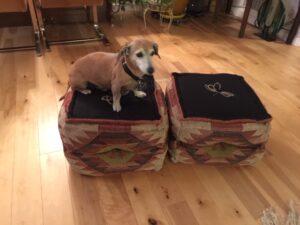 FG sent me a photo of her little dog perched on two ottomans covered in a tribal style wool fabric. She wants to know about them. That flat weave tapestry is Kilim re-purposed as upholstery fabric. Kilim rugs have a long tradition of MANY uses, so the modern ottomans fit with the history of the pileless tapestry always found in geometric designs. Almost all fabric needs used Kilim within a traditional Middle Eastern home for 2,000 years.
FG sent me a photo of her little dog perched on two ottomans covered in a tribal style wool fabric. She wants to know about them. That flat weave tapestry is Kilim re-purposed as upholstery fabric. Kilim rugs have a long tradition of MANY uses, so the modern ottomans fit with the history of the pileless tapestry always found in geometric designs. Almost all fabric needs used Kilim within a traditional Middle Eastern home for 2,000 years.
Why a no pile rug?
Because a flat continuous weave, no cut threads, meant durability. Plus the rug is reversible. Families passed these rugs on for generations.
Weaving technique usually use slit weave, but these rugs have survived for 2,000 plus years. So weaving techniques, intended uses, and designs themselves reflect changes in empires, climate, economics, and culture. If we read the patterns in the geometric designs and their symbolism, we could trace influences over time. I showed FG a little of how I look at Kilim rugs, and what I look for as to levels of value. Popular today as flat floor coverings, we find MANY reproductions of all levels of value and levels of “cultural reinterpretation.”
Kilim Origins
Kilim originated in Anatolia (Turkey) between the Black and Mediterranean Seas. As cultures crossed paths in this area, so did styles of Kilim, and as Western traders moved to trade as well as other Eastern traders, Kilim patterns changed.
Weavers developed the style thousands of years ago in the former Persian Empire (Iran, the Balkans, and Turkic Cultures). Indispensable for life, people used them for tent coverings, wall hangings to keep heat out or in, saddle blankets, shoes, prayer rugs, wedding proposals, etc. We find the oldest Kilim in 5th century China, made in the same way as today. Weavers loop colors, and separate colors by a clear slit/space. This results in a crisp geometric design, thus the medium and the design become one. Bend a good Kilim and you see those slits between the colors. Weavers usually employ 14 wool thread warp and 16 Threads weft (sometimes of cotton).
Stylistic and Symbolic
Lest you think the geometric designs only stylistic, they also display symbols. A diamond or chevron shape with a black square to the center protects against the evil eye. A crooked snake-like head on a line indicates protection from stings. Stylistic teeth in an octagonal shape indicates a Shepherd’s flock protected against the mouth of the wolf.
For the last 200 years of European home décor the wealthy favored deep pile Persian rugs. People considered the flat weave, simpler Kilim merely functional tribal craftwork. Because the Western market favored deep pile Persian rugs, makers made what the West wanted. They didn’t easily adopt more traditional symbolic patterns into the fine mansion homes. Because of the taste for “richer” rugs, the Kilim developed into the 20th century as it always flourished, free from Western tastes. But in the 1980s decorators recognized the flat weave rug as a design feature in a modern Western home. Textile historians bemoan the popularity of the Kilim in the Western market, as the market has changed the way weavers weave Kilim.
What to look for in Kilim
Look for an effect called abrash, the fluctuations of color found ONLY when the dyer uses non-chemical (vegetable) dye,. These cannot be colorfast, and take color differently depending on the oil content of the wool dyed. Modern Kilim are generally dyed with aniline (chemical) dyes, which give them a uniformity of color and very bright colors. The technique of dying indicates value. Certain villages still stick with vegetable dyes, in the traditional way, these Kilim are of course more expensive.
Another key to value is the place of origin, with Anatolia (Turkish) Kilims the most desirable. Generations of weavers made Kilim in panels of three feet each, the width of a floor loom around for centuries. Look for panels of three feet each, sewn together. The value of FG’s pair of Kilim ottomans is $600 for the pair. The dog is priceless.
Pingback: Navajo Rugs In Rare Condition - Elizabeth Appraisals